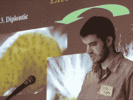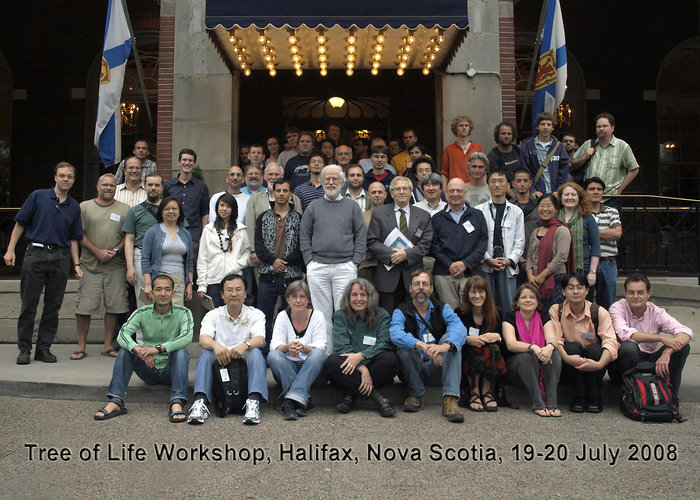In the last decade, advances in a variety of fields ranging from molecular biology and genomics, to statistics and phylogenetic reconstruction methods, to environmental surveys and the description of new species, have in combination led to a significant improvement of our understanding of protist diversity and evolution. To recognize these advances, and to establish a flexible resource to concentrate and distribute our knowledge about the biology and diversity of microbial eukaryotes in the context of the phylogenetic relationships among protists, a group of protistologists began to organize a massive update of the “protist” sections of the Tree of Life Web Project.
The goal was to achieve this in a single, substantial push in the summer of 2008, facilitated by a workshop. Members of the protist research community were chosen to update various branches of the Tree of Life Web Project, and contributors gathered in Halifax on the eve of the combined meeting of the International Society for Evolutionary Protistology and International Society of Protistologists, and presented an overview of each group. The workshop served as the focal point for the individual efforts to update the Tree of Life, but also presented a unique opportunity for a ‘crash course’ in eukaryotic biodiversity of a type never offered before. Experts of all major protozoan and algal groups were on hand and presented their summary of the basic biology, structure, molecular biology, and phylogenetics of their group. For anyone interested in brushing up on the state-of-the-art-outside the groups they know best, or for people relatively new to the field and wanting a ‘protist-emersion’ experience, this workshop offered a unique opportunity. The topics the contributors were asked to cover were not restricted to the systematics and phylogeny of a group; speakers were encouraged to provide a more comprehensive summary about the biology of each group and what makes them interesting.
Several of the branch pages developed in the context of these efforts are now available on the Tree of Life Web Project and additional pages will be published over the next few years. Here is an overview of the workshop presentations with links to those pages that have already been published.
 | Introduction to the Tree of Web Project David Maddison, University of Arizona, Tucson, Arizona, USA
About the Tree of Life Web Project |
 | Background and the Tree of Eukaryotes Patrick Keeling, University of British Columbia, Vancouver, British Columbia, Canada
Eukaryotes |
 | Microsporidia Jiri Vavra, University of South Bohemia, Ceske Budejovice, Czech Republic |
 | Amoebozoa Jeff Silberman, University of Arkansas, Fayetteville, Arkansas, USA
|
 | Lobosea Alexey Smirnov, St. Petersburg State University, St. Petersburg, Russia
|
 | Slime Molds (Eumycetozoa) Fred Spiegel, University of Arkansas, Fayetteville, Arkansas, USA |
 | Testate Amoebozoa (Arcellinida) Ralf Meisterfeld, Rheinisch-Westfälische Technische Hochschule Aachen, Germany Arcellinida |
 | Introduction to Excavates, Jacobids
Alastair Simpson, Dalhousie University, Halifax, Nova Scotia, Canada Jakobida |
 | Euglenids Brian Leander, University of British Columbia, Vancouver, British Columbia, Canada
Euglenida |
 | Kinetoplastids Julius Lukes, University of South Bohemia, Ceske Budejovice, Czech Republic Kinetoplastida |
 | Parabasalia Patrick Keeling, University of British Columbia, Vancouver, British Columbia, Canada
Kevin Carpenter, University of British Columbia, Vancouver, British Columbia, Canada
|
 | Oxymonads Kevin Carpenter, University of British Columbia, Vancouver, British Columbia, Canada
Vladimir Hampl, Dalhousie University, Halifax, Nova Scotia, Canada
Patrick Keeling, University of British Columbia, Vancouver, British Columbia, Canada
|
 | Fornicata (Diplomonads and Retortamonads) Ivan Cepicka, Charles University, Prague, Czech Republic Fornicata |
 | Haptophytes Colomban de Vargas, Station Biologique de Roscoff, Roscoff, France
|
 | Cryptophytes (Cryptomonads)
John Archibald, Dalhousie University, Halifax, Nova Scotia, Canada
Kerstin Hoef-Emden, Universität zu Köln, Köln, Germany Cryptomonads |
 | The Heterokont Algae: Class Eustigmatophyceae
J. Craig Bailey, Cory Dashiell, Lindsay Haus, University of North Carolina Wilmington, North Carolina, USA
|
 | The Brown Algae (Phaeophyceae)
Chris Lane, Dalhousie University, Halifax, Nova Scotia, Canada |
 | Oomycetes Gordon Beakes, Newcastle University, Newcastle upon Tyne, United Kingdom |
 | Diatoms David Mann, Royal Botanic Garden Edinburgh, United Kingdom
|
 | Ciliates Michaela Strueder-Kypke, University of Guelph, Guelph, Ontario, Canada
|

 | Dinoflagellates Mona Hoppenrath, Forschungsinstitut Senckenberg, German Centre for Marine Biodiversity Research, Wilhemshaven, Germany
Juan Saldarriaga, University of British Columbia, Vancouver, British Columbia, Canada Dinoflagellates |
 | Gregarines Sonja Rueckert, University of British Columbia, Vancouver, British Columbia, Canada
Brian Leander, University of British Columbia, Vancouver, British Columbia, Canada Gregarina |
 | Apicomplexa Jan Slapeta, University of Sydney, Sydney, New South Wales, Australia |
 | Rhizaria and Cercozoa
Tom Cavalier-Smith, Oxford University, Oxford, United Kingdom Cercozoa |
 | Testate Cercozoan Amoebae
Edward Mitchell, École Polytechnique Fédérale de Lausanne, Switzerland |
 | Chlorarachniophytes
Ken-ichiro Ishida, University of Tsukuba, Tsukuba, Japan Chlorarachniophytes |
 | Cryomonads, Thaumatomonads & relatives Chitchai Chantangsi, University of British Columbia, Vancouver, British Columbia, Canada
Brian Leander, University of British Columbia, Vancouver, British Columbia, Canada
|
 | Foraminifera
Jan Pawlowski, University of Geneva, Geneva, Switzerland |
| | General Discussion–Next Steps
|
Here are some other pages that were developed as a result of the workshop but that were not covered in the workshop: Alveolates, Heterolobosea, Stephanopogon.



































 Go to quick links
Go to quick search
Go to navigation for this section of the ToL site
Go to detailed links for the ToL site
Go to quick links
Go to quick search
Go to navigation for this section of the ToL site
Go to detailed links for the ToL site